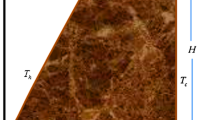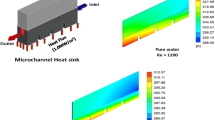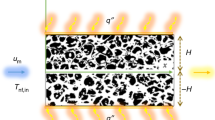Abstract
The present study analyzed the behavior of a hybrid nanofluid with the aim of improving its heat transfer in tubes filled with a porous medium, which is a metal foam in this case. To this end, the impact of changes in influential factors, namely the Reynolds number, nanofluid concentration, porosity, number of pores per inch and Prandtl number on the heat transfer performance of an Al2O3–Cu/water hybrid nanofluid in tubes containing a porous medium, was investigated via numerical simulation. According to the results, increases in Reynolds number (in the laminar flow range), nanofluid concentration, pores per inch, and Prandtl number improved the Nusselt number and, hence, the thermal performance of the nanofluid. In contrast, an increase in porosity in the studied range reduced Nusselt number, resulting in a drop in the thermal efficiency of the nanofluid. Subsequently, the thermal behavior of the Al2O3–Cu/water hybrid nanofluid was studied under the presence and absence of the porous medium. The results indicated the positive effect of the porous medium on the Nusselt number and, as a result, the thermal efficiency of the nanofluid. Ultimately, the data obtained from the numerical simulation were used to obtain a general Nusselt correlation for the Al2O3–Cu/water hybrid nanofluid under constant- and variable-porosity media. The accuracy of the Nusselt correlation produced for examining the thermal performance of the hybrid nanofluid was 98% for the constant-porosity medium and 96% for the variable-porosity medium.

















Similar content being viewed by others
Abbreviations
- A, a :
-
Specific surface area (m2)
- C p :
-
Specific heat (J kg−1 K−1)
- d np :
-
Particle diameter (nm)
- d f :
-
Diameter of the fiber of metal foam (nm)
- h :
-
Heat transfer coefficient (W m−2 K−1)
- K :
-
Permeability (m2)
- k :
-
Thermal conductivity (W m−1 K−1)
- k eff :
-
Effective thermal conductivity (W m−1 K−1)
- L :
-
Tube length (mm)
- Nu:
-
Nusselt number
- Pr:
-
Prandtl number
- Q w :
-
Wall heat flux (W m−2)
- r :
-
Radius of the pipe (mm)
- Re:
-
Reynolds number
- T :
-
Temperature (K)
- u :
-
Velocity at x axis (m s−1)
- bf:
-
Base fluid
- eff:
-
Effective property
- exp:
-
Experimental
- f:
-
Fluid
- hnf:
-
Hybrid nanofluid
- in:
-
Inlet
- n:
-
Number of samples
- out:
-
Outlet
- PPI:
-
Pore per inch
- ref:
-
Reference state
- s:
-
Solid
- sim:
-
Simulation
- w:
-
Wall
- ε :
-
Porosity
- μ :
-
Dynamic viscosity (kg m−1 s−1)
- ρ :
-
Density (kg m−3)
- φ :
-
Volume fraction
References
Alagumalai A, Qin C, Vimal KE, Solomin E, Yang L, Zhang P, Otanicar T, Kasaeian A, Chamkha AJ, Rashidi MM, Wongwises S. Conceptual analysis framework development to understand barriers of nanofluid commercialization. Nano Energy. 2022. https://doi.org/10.1016/j.nanoen.2021.106736.
Mahian O, Bellos E, Markides CN, Taylor RA, Alagumalai A, Yang L, Qin C, Lee BJ, Ahmadi G, Safaei MR, Wongwises S. Recent advances in using nanofluids in renewable energy systems and the environmental implications of their uptake. Nano Energy. 2021. https://doi.org/10.1016/j.nanoen.2021.106069.
Achard F, Maxwell JC. A treatise on electricity and magnetism (1873). In: Landmark writings in western mathematics. 2005. p. 1640–1940. https://doi.org/10.1016/B978-044450871-3/50125-X.
Hamilton RL, Crosser OK. Thermal conductivity of heterogeneous two-component systems. Ind Eng Chem Fundam. 1962. https://doi.org/10.1021/i160003a005.
Masuda H, Ebata A, Teramae K. Alteration of thermal conductivity and viscosity of liquid by dispersing ultra-fine particles. Dispersion of Al2O3, SiO2 and TiO2 ultra-fine particles. Netsu Bussei. 1993. https://doi.org/10.2963/jjtp.7.227.
Choi SU, Eastman JA. Enhancing thermal conductivity of fluids with nanoparticles. Argonne: Argonne National Lab. (ANL); 1995.
Pourfayaz F, Sanjarian N, Kasaeian A, Razi Astaraei F, Sameti M, Nasirivatan S. An experimental comparison of SiO2/water nanofluid heat transfer in square and circular cross-sectional channels. J Therm Anal Calorim. 2018. https://doi.org/10.1007/s10973-017-6500-4.
Amani M, Ameri M, Kasaeian A. The experimental study of convection heat transfer characteristics and pressure drop of magnetite nanofluid in a porous metal foam tube. Transp Porous Media. 2017. https://doi.org/10.1007/s11242-016-0808-6.
Suresh S, Venkitaraj KP, Selvakumar P, Chandrasekar M. Effect of Al2O3–Cu/water hybrid nanofluid in heat transfer. Exp Therm Fluid Sci. 2012. https://doi.org/10.1016/j.expthermflusci.2011.11.007.
Moghadassi A, Ghomi E, Parvizian F. A numerical study of water based Al2O3 and Al2O3–Cu hybrid nanofluid effect on forced convective heat transfer. Int J Therm Sci. 2015. https://doi.org/10.1016/j.ijthermalsci.2015.01.025.
Bellos E, Tzivanidis C. Thermal analysis of parabolic trough collector operating with mono and hybrid nanofluids. Sustain Energy Technol Assess. 2018. https://doi.org/10.1016/j.seta.2017.10.005.
Hemmat Esfe M, Esfandeh S, Rejvani M. Modeling of thermal conductivity of MWCNT-SiO2 (30:70%)/EG hybrid nanofluid, sensitivity analyzing and cost performance for industrial applications. J Therm Anal Calorim. 2018. https://doi.org/10.1007/s10973-017-6680-y.
Ramadhan AI, Azmi WH, Mamat R, Hamid KA. Experimental and numerical study of heat transfer and friction factor of plain tube with hybrid nanofluids. Case Stud Therm Eng. 2020. https://doi.org/10.1016/j.csite.2020.100782.
Raja S, Vijayakumar K, Gangadevi R. A comparative study on thermal conductivity of Al2O3/water, CuO/water and Al2O3–CuO/water nanofluids. Dig J Nanomater Biostruct. 2015;10(4):1449–58.
Shahsavar A, Salimpour MR, Saghafian M, Shafii MB. An experimental study on the effect of ultrasonication on thermal conductivity of ferrofluid loaded with carbon nanotubes. Thermochim Acta. 2015. https://doi.org/10.1016/j.tca.2015.08.025.
Babar H, Sajid MU, Ali HM. Viscosity of hybrid nanofluids: a critical review. Therm Sci. 2019. https://doi.org/10.2298/TSCI181128015B.
Shahul Hameed M, Suresh S, Singh RK. Comparative study of heat transfer and friction characteristics of water-based Alumina–copper and Alumina–CNT hybrid nanofluids in laminar flow through pipes. J Therm Anal Calorim. 2019. https://doi.org/10.1007/s10973-018-7898-z.
Abbas F, Ali HM, Shaban M, Janjua MM, Shah TR, Doranehgard MH, Ahmadlouydarab M, Farukh F. Towards convective heat transfer optimization in aluminum tube automotive radiators: potential assessment of novel Fe2O3–TiO2/water hybrid nanofluid. J Taiwan Inst Chem Eng. 2021. https://doi.org/10.1016/j.jtice.2021.02.002.
Arif M, Kumam P, Khan D, Watthayu W. Thermal performance of GO-MoS2/engine oil as Maxwell hybrid nanofluid flow with heat transfer in oscillating vertical cylinder. Case Stud Therm Eng. 2021. https://doi.org/10.1016/j.csite.2021.101290.
Ekiciler R, Çetinkaya MS. A comparative heat transfer study between monotype and hybrid nanofluid in a duct with various shapes of ribs. Therm Sci Eng Prog. 2021. https://doi.org/10.1016/j.tsep.2021.100913.
Alawi OA, Kamar HM, Hussein OA, Mallah AR, Mohammed HA, Khiadani M, Roomi AB, Kazi SN, Yaseen ZM. Effects of binary hybrid nanofluid on heat transfer and fluid flow in a triangular-corrugated channel: an experimental and numerical study. Powder Technol. 2022. https://doi.org/10.1016/j.powtec.2021.09.046.
Buonomo B, Manca O, Lauriat G. Forced convection in micro-channels filled with porous media in local thermal non-equilibrium conditions. Int J Therm Sci. 2014. https://doi.org/10.1016/j.ijthermalsci.2013.11.003.
Xu H, Xing Z, Vafai K. Analytical considerations of flow/thermal coupling of nanofluids in foam metals with local thermal non-equilibrium (LTNE) phenomena and inhomogeneous nanoparticle distribution. Int J Heat Fluid Flow. 2019. https://doi.org/10.1016/j.ijheatfluidflow.2019.04.009.
Lu W, Zhao CY, Tassou SA. Thermal analysis on metal-foam filled heat exchangers. Part I: metal-foam filled pipes. Int J Heat Mass Transf. 2006. https://doi.org/10.1016/j.ijheatmasstransfer.2005.12.012.
Calmidi VV, Mahajan RL. Forced convection in high porosity metal foams. J Heat Transf. 2000. https://doi.org/10.1115/1.1287793.
Kim SY, Paek JW, Kang BH. Flow and heat transfer correlations for porous fin in a plate-fin heat exchanger. J Heat Transf. 2000. https://doi.org/10.1115/1.1287170.
Khanafer K, Vafai K. A critical synthesis of thermophysical characteristics of nanofluids. Int J Heat Mass Transf. 2011. https://doi.org/10.1016/j.ijheatmasstransfer.2011.04.048.
Corcione M. Heat transfer features of buoyancy-driven nanofluids inside rectangular enclosures differentially heated at the sidewalls. Int J Therm Sci. 2010. https://doi.org/10.1016/j.ijthermalsci.2010.05.005.
Bianco V, Scarpa F, Tagliafico LA. Numerical analysis of the Al2O3–water nanofluid forced laminar convection in an asymmetric heated channel for application in flat plate PV/T collector. Renew Energy. 2018. https://doi.org/10.1016/j.renene.2017.09.067.
Kakaç S, Shah RK, Bergles AE, editors. Low Reynolds number flow heat exchangers: advanced study institute book. New York: Hemisphere Publishing Corporation; 1983.
Churchill SW, Ozoe H. Correlations for laminar forced convection with uniform heating in flow over a plate and in developing and fully developed flow in a tube. J Heat Transf. 1973. https://doi.org/10.1115/1.3450009.
Zhu G, Bi Q, Yan J, Wang T, Zhao J. Heat transfer characteristics of subcooled water in a hypervapotron under high mass fluxes and high heat fluxes. Int J Heat Mass Transf. 2019. https://doi.org/10.1016/j.ijheatmasstransfer.2018.09.102.
Shah RK. A correlation for laminar hydrodynamic entry length solutions for circular and noncircular ducts. J Fluids Eng. 1978. https://doi.org/10.1115/1.3448626.
Author information
Authors and Affiliations
Corresponding author
Additional information
Publisher's Note
Springer Nature remains neutral with regard to jurisdictional claims in published maps and institutional affiliations.
Rights and permissions
About this article
Cite this article
Shahabi Nejad, A., Fallah Barzoki, M., Rahmani, M. et al. Simulation of the heat transfer performance of Al2O3–Cu/water binary nanofluid in a homogenous copper metal foam. J Therm Anal Calorim 147, 12495–12512 (2022). https://doi.org/10.1007/s10973-022-11487-1
Received:
Accepted:
Published:
Issue Date:
DOI: https://doi.org/10.1007/s10973-022-11487-1




